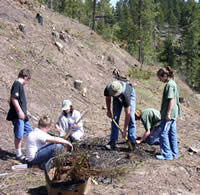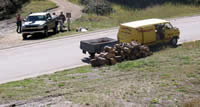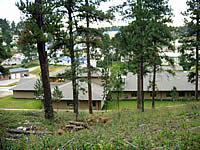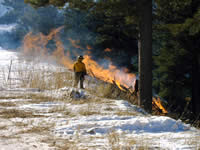
National Fire Plan Success Story
Community Assistance Program "Assists" Firewise Lead Program
Lead, South Dakota
National Fire Plan - Community Assistance

Firewise volunteer assisting children to plant aspen and birch seedlings during Arbor Day.

Firewood created from thinning project that is available for public use.

Hazardous Fuels Reduction project completed by the Firewise Lead program behind an assisted living complex within the Lead city limits.

Firewise Lead crew member burning slash piles created from hazardous fuels reduction projects.
The community of Lead (pronounced Leed) is located in the Northern Black Hills of South Dakota. Rugged hillsides and canyons surround Lead where the predominant growth is Ponderosa Pine, Black Hills Spruce and scattered stands of aspen and birch. In June 2002, the community was threatened by the devastating Grizzly Gulch Fire, which burned over 10,000 acres and prompted an evacuation of the entire community.
In September 2002, the Lead Fire Department received a grant from the Western Governor's Association and the Bureau of Land Management to establish a "Community Fire Action Plan" within the City of Lead. This plan identified areas of high risk within and immediately adjacent to the city limits. In 2003, Firewise Lead was created. The primary objective of Firewise Lead is to create defensible space within the forest area around the perimeter of the community. Utilizing a program of eliminating under-story growth, minimizing ladder fuels and managing crown spacing, Firewise Lead has created defensible space around 65 percent of the community.
In addition to fieldwork, Firewise Lead organizes community information programs to introduce themselves to the community and to educate the public on proper fire protection. This type of community service is an on going effort that provides individual site visits, public collection of firewood, and collection of donations for public food cupboards. Firewise Lead has been accepted as an important member of the Lead community. The primary goal of the Education Division is to inform local residents of the importance of hazardous fuels reduction.
Recently, the Firewise Lead crew has been busy. The recent snowfalls have allowed safe burning of previously built slash piles. The crew began the season with over 3,000 slash piles and through January has burned over 75 percent of the slash piles. The crew has also worked with the Homestake Mining Company in burning large machine piles. The Firewise Lead crew recently completed the prescription plan for the northwest section of Lead and will move to the northeast section where work is expected to continue for several years.
To date, the Lead Firewise Program has treated approximately 300 acres within and adjacent to the city limits. The result in treating these 300 acres has resulted in the protection of both private residences and the infrastructure of the community. The Bureau of Land Management, South Dakota Field Office has contributed greatly to the funding of this nationally renowned program. The Firewise Lead Program Director has successfully applied for, and been granted, Community Assistance money from the Bureau of Land Management. These Community Assistance dollars from the BLM has kept this program moving forward. Bureau of Land Management statistics have shown that the City of Lead is one of the five most endangered cities in the United States from wildland fire. Without the assistance from outside funding, this program would cease to exist.
Contact: Cory Neuharth at 605-720-2058.